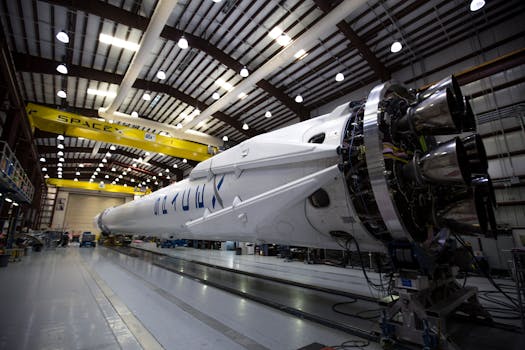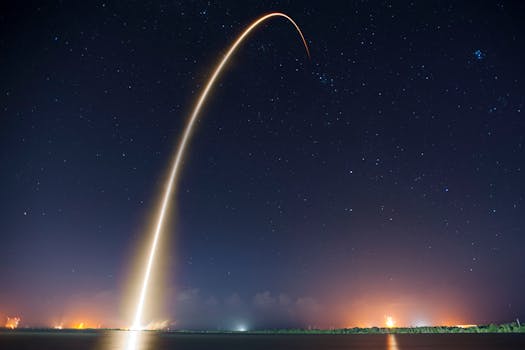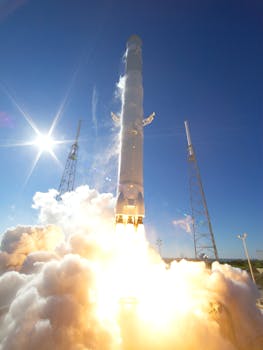Indice
- Introduction: The Revolutionary Concept of Reusable Rockets
- The Falcon 9: SpaceX’s Flagship Reusable Rocket
- Key Technologies Enabling Precise Rocket Landings
- Step-by-Step: The Intricate Landing Process
- Economic and Environmental Benefits of Reusable Rockets
- Overcoming Challenges in Rocket Recovery and Reuse
- Future Improvements and Innovations in Reusable Rocket Technology
- SpaceX’s Major Milestones and Record-Breaking Landings
- How SpaceX’s Technology Compares to Other Space Companies
- Current Limitations and Areas for Improvement
- The Impact of Reusable Rockets on Space Exploration and Commercialization
- Conclusion: The Future of Space Travel with Reusable Rockets
Introduction: The Revolutionary Concept of Reusable Rockets
The Dawn of a New Space Era
The concept of reusable rockets has ushered in a new era of space exploration and commercial spaceflight. SpaceX, founded by Elon Musk in 2002, has been at the forefront of this revolutionary technology. The ability to land and reuse rockets has dramatically reduced the cost of space launches, making space more accessible than ever before. This breakthrough has not only transformed the economics of spaceflight but has also opened up new possibilities for scientific research, satellite deployment, and even space tourism.
The Economics of Reusability
Traditional rockets were designed for single-use, with their components either burning up in the atmosphere or falling into the ocean after launch. This approach led to enormous costs, with each launch essentially requiring a brand-new rocket. SpaceX’s reusable rocket technology has changed this paradigm. By recovering and refurbishing the first stage of their Falcon 9 rockets, SpaceX has reportedly reduced launch costs by up to 30%. This significant cost reduction has made space launches more frequent and affordable, benefiting both commercial and scientific missions.
Environmental Impact and Sustainability
Beyond the economic advantages, reusable rockets also offer significant environmental benefits. By reducing the need for manufacturing new rockets for each launch, the carbon footprint associated with space exploration is substantially decreased. Additionally, the ability to land rockets precisely minimizes the environmental impact of discarded rocket stages. This aspect of sustainability aligns with growing global concerns about space debris and the responsible use of Earth’s orbital environment. As space activities continue to increase, the importance of sustainable practices in spaceflight becomes ever more crucial.
The Falcon 9: SpaceX’s Flagship Reusable Rocket

Design and Capabilities
The Falcon 9 is SpaceX’s workhorse rocket, designed for the reliable and safe transport of satellites and spacecraft to orbit. Standing at 70 meters tall and 3.7 meters in diameter, this two-stage rocket is capable of carrying payloads of up to 22,800 kilograms to low Earth orbit. The Falcon 9’s first stage is powered by nine Merlin engines, which provide a combined thrust of 7,607 kilonewtons at sea level. What sets the Falcon 9 apart is its reusable first stage, which can land vertically on both land and autonomous drone ships at sea, a feature that has revolutionized the economics of space travel.
Landing Technology
The ability of the Falcon 9’s first stage to land is made possible through a series of innovative technologies. During descent, the rocket uses grid fins for steering and attitude control, while its engines perform a series of burns to slow its descent. The landing legs deploy just before touchdown to stabilize the rocket. This process is controlled by advanced guidance systems and algorithms that make split-second adjustments to ensure a precise landing. The success rate of these landings has steadily improved since the first successful attempt in 2015, with SpaceX now routinely recovering and reusing first stages.
Reusability and Rapid Relaunch
One of the most remarkable aspects of the Falcon 9 is its rapid reusability. SpaceX has demonstrated the ability to relaunch a recovered first stage in as little as 27 days after its previous mission. This quick turnaround time is crucial for reducing costs and increasing launch frequency. The company’s goal is to eventually reuse each first stage up to 10 times with minimal refurbishment between flights, and up to 100 times with periodic maintenance. This level of reusability has the potential to dramatically reduce the cost of access to space, opening up new opportunities for scientific research, commercial applications, and space exploration.
Key Technologies Enabling Precise Rocket Landings
Advanced Guidance and Control Systems
The precision landing of SpaceX rockets is made possible by a suite of advanced guidance and control systems. At the heart of this technology is a sophisticated inertial measurement unit (IMU) that provides real-time data on the rocket’s position, velocity, and orientation. This information is processed by powerful onboard computers running complex algorithms that calculate the optimal trajectory for landing. The system continuously adjusts the rocket’s path, accounting for variables such as wind speed and atmospheric conditions. Additionally, SpaceX employs GPS technology for enhanced positional accuracy, especially crucial for landings on drone ships in the ocean.
Innovative Propulsion and Maneuvering
SpaceX’s landing technology relies heavily on innovative propulsion and maneuvering systems. The SuperDraco engines, originally designed for the Crew Dragon spacecraft’s launch escape system, have been adapted for use in the landing process. These engines provide precise thrust control, allowing for last-minute adjustments during descent. The rocket’s grid fins, made of titanium, play a crucial role in steering the vehicle through the atmosphere. These fins can withstand extreme temperatures and provide aerodynamic control at hypersonic speeds. The combination of these technologies allows for unprecedented accuracy in rocket landings, with the ability to adjust for unexpected conditions in real-time.
Machine Learning and Artificial Intelligence
SpaceX has increasingly incorporated machine learning and artificial intelligence into its landing systems. These technologies analyze data from previous landings to continually improve the accuracy and efficiency of future attempts. AI algorithms can predict potential issues and make split-second decisions to optimize the landing process. For example, machine learning models help in determining the best approach trajectory based on current weather conditions and the specific characteristics of the landing site. This constant learning and adaptation have significantly contributed to SpaceX’s impressive success rate in rocket landings, pushing the boundaries of what’s possible in aerospace engineering.
Step-by-Step: The Intricate Landing Process
Initiating the Landing Sequence
The landing process of a SpaceX rocket begins shortly after the first stage separation. As the second stage continues its journey to deliver the payload, the first stage initiates a complex series of maneuvers. The first crucial step is the boostback burn, where the rocket flips 180 degrees and fires its engines to reverse its horizontal velocity and begin its journey back to the landing site. This burn is precisely calculated to put the rocket on a trajectory that intersects with the designated landing area, whether it’s on land or at sea on a drone ship.
Atmospheric Re-entry and Controlled Descent
As the rocket re-enters the Earth’s atmosphere, it faces extreme temperatures and forces. To manage this, SpaceX employs a technique called supersonic retropropulsion. The rocket fires its engines while moving at supersonic speeds, which helps to slow its descent and protect it from the intense heat of re-entry. During this phase, the grid fins deploy and begin to steer the rocket, providing crucial aerodynamic control. The onboard computers continuously adjust the rocket’s attitude and trajectory, compensating for winds and other atmospheric conditions. This phase culminates in the entry burn, a longer engine firing that further slows the rocket and helps protect its components from the heat of re-entry.
Final Approach and Touchdown
The final moments of landing are perhaps the most critical. As the rocket approaches the landing zone, it performs the landing burn. This burn begins at high thrust to rapidly slow the rocket’s descent. The thrust is then throttled down as the rocket nears the ground, allowing for a gentle touchdown. Seconds before landing, the rocket deploys its four landing legs. The onboard guidance system makes final micro-adjustments to ensure the rocket remains vertical and centered on the landing pad. For sea landings, the system also compensates for the motion of the drone ship. The entire process, from boostback burn to touchdown, takes approximately 8-10 minutes and represents one of the most impressive feats of precision engineering in aerospace history.
Economic and Environmental Benefits of Reusable Rockets
Cost Reduction and Market Transformation
The advent of reusable rockets, spearheaded by SpaceX, has led to a dramatic reduction in launch costs. Traditional expendable rockets cost between $150 million to $300 million per launch. In contrast, SpaceX’s Falcon 9 launches cost around $62 million, with the potential to decrease further as reusability improves. This significant cost reduction has not only made space more accessible but has also stimulated the growth of the commercial space industry. New businesses and applications, such as satellite internet constellations and space tourism, are becoming economically viable. The lower costs have also enabled more frequent scientific missions and experiments in space, accelerating research and development in various fields.
Environmental Impact and Sustainability
Reusable rockets offer substantial environmental benefits compared to their expendable counterparts. The manufacturing process of rockets is resource-intensive and generates significant carbon emissions. By reusing the first stage, which accounts for about 70% of the rocket’s cost, SpaceX reduces the environmental impact of each launch. Furthermore, the precision landing capabilities of these rockets minimize the dispersion of space debris, a growing concern in the space industry. The reduction in space junk contributes to the long-term sustainability of space activities. Additionally, SpaceX has been exploring the use of methane as a fuel for its next-generation Starship, which has the potential to be produced on Mars, further enhancing the sustainability of future space exploration missions.
Innovation Spillover and Economic Growth
The development of reusable rocket technology has spurred innovation across various sectors. Technologies developed for precise rocket landings, such as advanced guidance systems and materials resistant to extreme conditions, have applications in other industries. For instance, the grid fin technology used in Falcon 9 landings could be adapted for use in high-speed aircraft or hypersonic vehicles. The economic impact extends beyond the space industry, creating jobs in manufacturing, engineering, and research. A study by the U.S. Department of Commerce estimated that the commercial space industry could become a $1 trillion market by 2040, largely driven by innovations like reusable rockets. This growth has the potential to stimulate economic development and technological advancement on a global scale.
Overcoming Challenges in Rocket Recovery and Reuse
Thermal Management and Material Fatigue
One of the most significant challenges in rocket recovery and reuse is managing the extreme thermal stresses experienced during re-entry and landing. The rocket’s first stage endures temperatures exceeding 1,000°C (1,832°F) as it re-enters Earth’s atmosphere at hypersonic speeds. SpaceX has addressed this challenge by developing advanced heat-resistant materials and innovative cooling systems. The grid fins, for instance, are made from titanium, which can withstand higher temperatures than the previously used aluminum fins. Additionally, SpaceX engineers have implemented sophisticated thermal protection systems to shield critical components from the intense heat. Despite these advancements, repeated exposure to extreme temperatures can lead to material fatigue, requiring careful inspection and maintenance between flights to ensure safety and reliability.
Precision Landing in Varying Conditions
Achieving consistent precision in rocket landings across diverse environmental conditions poses another significant challenge. Factors such as wind speed, atmospheric pressure, and sea state (for ocean landings) can dramatically affect the landing process. SpaceX has tackled this challenge by developing highly advanced guidance and control systems. These systems use real-time data from various sensors, including radar altimeters and wind meters, to make split-second adjustments during descent. For sea landings, the challenge is further complicated by the movement of the drone ship. To address this, SpaceX has implemented a system that can predict wave patterns and adjust the ship’s position to compensate for ocean currents. Despite these innovations, extreme weather conditions can still force the postponement of landing attempts, highlighting the ongoing nature of this challenge.
Rapid Turnaround and Refurbishment
Achieving a rapid turnaround time between launches is crucial for maximizing the economic benefits of reusable rockets. However, this presents significant logistical and technical challenges. After each landing, the rocket undergoes a thorough inspection and refurbishment process. This includes checking for structural integrity, replacing worn components, and recertifying critical systems. SpaceX has made significant strides in streamlining this process, reducing the turnaround time from months to weeks. The company’s goal is to achieve a 24-hour turnaround time, which would revolutionize space launch capabilities. To this end, SpaceX is continually refining its design and maintenance procedures, using data from each flight to identify areas for improvement. The company is also investing in automated inspection technologies and developing more durable components to reduce the time and cost of refurbishment, pushing the boundaries of what’s possible in rocket reusability.
Future Improvements and Innovations in Reusable Rocket Technology
Advanced Materials and Manufacturing Techniques
The future of reusable rocket technology heavily relies on the development of advanced materials and manufacturing techniques. Researchers are exploring new alloys and composites that can withstand extreme temperatures and stresses while remaining lightweight. For instance, the use of carbon nanotubes and graphene-based materials could significantly reduce the weight of rocket components while increasing their strength and heat resistance. Additionally, advancements in 3D printing technology, particularly in metal additive manufacturing, are enabling the production of complex rocket parts with improved performance characteristics and reduced manufacturing time and cost.
Next-Generation Propulsion Systems
Innovations in propulsion systems are set to revolutionize reusable rocket technology. SpaceX and other companies are investing in the development of methalox engines, which use liquid methane and liquid oxygen as propellants. These engines offer several advantages over traditional kerosene-based systems, including higher performance, easier reusability, and the potential for in-situ fuel production on Mars. Furthermore, research into nuclear thermal propulsion and electric propulsion systems could dramatically increase the efficiency of space travel, potentially enabling faster interplanetary missions and more frequent Earth orbit operations.
Artificial Intelligence and Autonomous Systems
The integration of artificial intelligence and autonomous systems is expected to play a crucial role in the future of reusable rockets. Advanced AI algorithms could optimize flight paths, predict maintenance needs, and even make real-time decisions during critical mission phases. This could lead to improved landing accuracy, reduced turnaround times, and enhanced safety. Moreover, the development of fully autonomous rockets capable of self-diagnosis and self-repair could significantly reduce operational costs and increase the frequency of launches. As these technologies mature, we may see a new era of space exploration where rockets can operate with minimal human intervention, opening up new possibilities for both Earth orbit operations and deep space missions.
SpaceX’s Major Milestones and Record-Breaking Landings

Revolutionary Achievements in Space Technology
SpaceX has consistently pushed the boundaries of space technology, achieving numerous milestones that have reshaped the aerospace industry. One of the company’s most significant accomplishments was the successful landing of the Falcon 9 first stage in December 2015, marking the first time an orbital-class rocket landed vertically after a launch. This achievement paved the way for the era of reusable rockets. In 2017, SpaceX made history again by relaunching and re-landing a used Falcon 9 first stage, demonstrating the viability of rocket reusability. The company has also set records for the number of times a single booster has been reused, with some Falcon 9 first stages flying more than 10 missions.
Record-Breaking Landings and Rapid Reusability
SpaceX’s landing success rate has improved dramatically since its first attempts. As of 2023, the company has successfully landed Falcon 9 first stages over 100 times, with a success rate exceeding 90%. These landings have occurred both on land at designated Landing Zones and at sea on autonomous drone ships. One of the most impressive feats was the simultaneous landing of two Falcon Heavy side boosters in February 2018, showcasing the precision and reliability of SpaceX’s landing technology. The company has also made significant strides in reducing the turnaround time between flights. In 2020, SpaceX set a record by reflying a Falcon 9 booster just 51 days after its previous mission, demonstrating the efficiency of their refurbishment process.
Advancing Human Spaceflight and Interplanetary Ambitions
Beyond cargo missions, SpaceX has made substantial progress in human spaceflight. In May 2020, the company successfully launched NASA astronauts to the International Space Station aboard the Crew Dragon spacecraft, becoming the first private company to send humans to orbit. This achievement marked the return of crewed launches from American soil after a nine-year hiatus. Looking to the future, SpaceX is developing the Starship, a fully reusable launch vehicle designed for missions to the Moon, Mars, and beyond. In 2022, SpaceX conducted successful high-altitude tests of Starship prototypes, bringing the company closer to its goal of interplanetary travel. These achievements not only demonstrate SpaceX’s technical prowess but also highlight the company’s role in shaping the future of space exploration and commerce.
How SpaceX’s Technology Compares to Other Space Companies

Reusability and Cost-Effectiveness
SpaceX has set itself apart in the space industry with its focus on reusable rocket technology. While other companies like Blue Origin and Rocket Lab are also developing reusable systems, SpaceX’s Falcon 9 remains the most frequently flown and recovered orbital-class rocket. This reusability has allowed SpaceX to offer launch prices significantly lower than its competitors. For instance, SpaceX’s Falcon 9 launches cost around $62 million, compared to the United Launch Alliance’s Atlas V, which can cost up to $150 million per launch. This cost advantage has disrupted the market, forcing other companies to adapt and innovate to remain competitive.
Launch Frequency and Payload Capacity
SpaceX has demonstrated an unparalleled launch cadence in the commercial space industry. In 2022, SpaceX conducted over 60 launches, far surpassing other private companies and even national space agencies. This high frequency is partly due to the rapid reusability of their rockets and streamlined operations. In terms of payload capacity, SpaceX’s Falcon Heavy can lift up to 63.8 metric tons to low Earth orbit, making it the most powerful operational rocket. This surpasses the capability of other heavy-lift rockets like United Launch Alliance’s Delta IV Heavy, which can carry about 28.4 metric tons to LEO. However, NASA’s Space Launch System (SLS) and Blue Origin’s New Glenn, when operational, are expected to challenge SpaceX’s dominance in heavy-lift capabilities.
Innovation in Spacecraft and Future Plans
SpaceX’s innovation extends beyond rockets to spacecraft design. The company’s Crew Dragon capsule is currently the only U.S. spacecraft certified to carry astronauts to the International Space Station, competing with Boeing’s troubled Starliner. Looking to the future, SpaceX’s ambitious Starship project aims to create a fully reusable launch system capable of interplanetary travel. While other companies like Blue Origin with its New Glenn rocket and NASA with its Artemis program are also targeting deep space exploration, SpaceX’s aggressive development timeline and innovative approach to testing (including rapid prototyping and iterative design) have garnered significant attention. This forward-thinking strategy has positioned SpaceX at the forefront of space exploration technology, challenging both private companies and national space agencies to keep pace with its rapid advancements.
Current Limitations and Areas for Improvement
Payload Capacity Constraints
While SpaceX’s Falcon 9 and Falcon Heavy rockets have revolutionized space launches, they still face limitations in terms of payload capacity. The Falcon 9 can lift up to 22,800 kg to low Earth orbit, which, while impressive, may not be sufficient for some of the more ambitious future space missions. This limitation becomes particularly apparent when considering missions beyond Earth orbit, such as those to the Moon or Mars. The development of the Starship aims to address this, with a projected payload capacity of over 100 metric tons to low Earth orbit. However, the Starship is still in development, and achieving this capacity while maintaining reusability presents significant engineering challenges.
Reusability Limits and Refurbishment Costs
Despite the significant advancements in reusability, current SpaceX rockets still have limitations on the number of times they can be reused. The Falcon 9 boosters are designed for up to 10 flights with minimal refurbishment, but beyond this, more extensive and costly refurbishment is required. The cost and time associated with this refurbishment can impact the economic benefits of reusability. Additionally, the upper stage of the Falcon 9 remains expendable, which represents a significant portion of the overall launch cost. SpaceX is working to address these limitations with the fully reusable Starship, but achieving full and rapid reusability of all components remains a complex challenge.
Environmental Concerns and Space Debris
While reusable rockets offer environmental benefits compared to expendable ones, there are still concerns about their impact. The production of rocket fuel and the emissions from launches contribute to environmental issues. Moreover, as the frequency of launches increases, there’s growing concern about the accumulation of space debris in Earth’s orbit. Although SpaceX has made efforts to de-orbit old satellites and rocket stages, the long-term sustainability of frequent launches and the potential for orbital congestion remain significant challenges. Addressing these environmental concerns while continuing to expand space access will be crucial for SpaceX and the entire space industry in the coming years.
The Impact of Reusable Rockets on Space Exploration and Commercialization
Revolutionizing Space Access
The advent of reusable rockets, pioneered by SpaceX, has dramatically transformed the landscape of space exploration and commercialization. By significantly reducing launch costs, reusable rockets have made space more accessible than ever before. The Falcon 9, SpaceX’s workhorse, has decreased launch costs by up to 30% compared to traditional expendable rockets. This cost reduction has enabled a surge in satellite deployments, scientific missions, and even paved the way for space tourism. Companies like Starlink have leveraged this technology to launch massive satellite constellations, aiming to provide global internet coverage. The increased frequency of launches has also accelerated scientific research, allowing more experiments to be conducted in microgravity environments.
Fostering a New Space Economy
Reusable rockets have been instrumental in fostering a thriving new space economy. The reduced barriers to entry have encouraged startups and entrepreneurs to enter the space sector, leading to innovations in satellite technology, space manufacturing, and even plans for space hotels. This economic boom has attracted significant investment, with the global space economy projected to reach $1 trillion by 2040, according to Bank of America Merrill Lynch. The commercialization of space has also led to job creation in various sectors, from aerospace engineering to satellite operations and data analysis. Furthermore, the competition sparked by SpaceX’s success has motivated established aerospace companies to innovate, driving further advancements in space technology.
Enabling Ambitious Exploration Missions
The cost-effectiveness and reliability of reusable rockets have reinvigorated plans for ambitious space exploration missions. NASA’s Artemis program, aimed at returning humans to the Moon, heavily relies on SpaceX’s Starship for its Human Landing System. This collaboration demonstrates how reusable rocket technology is enabling more complex and far-reaching missions. Beyond lunar exploration, reusable rockets are crucial for realizing plans for human missions to Mars. The ability to launch multiple supply missions cost-effectively is essential for establishing a sustainable presence on other celestial bodies. Moreover, the development of fully reusable systems like Starship promises to revolutionize interplanetary travel, potentially making regular trips to Mars a reality in the coming decades.
Conclusion: The Future of Space Travel with Reusable Rockets
Transforming Space Exploration
The advent of reusable rockets, spearheaded by SpaceX, has ushered in a new era of space exploration. This technology has dramatically reduced the cost of space launches, making frequent missions and ambitious projects more feasible than ever before. With the ability to reuse rocket boosters multiple times, companies like SpaceX have slashed launch costs by up to 30%, opening up space to a wider range of commercial and scientific endeavors. This cost reduction is not just about savings; it’s about enabling a future where space travel becomes routine, paving the way for more frequent scientific missions, commercial satellite deployments, and even space tourism.
Advancing Interplanetary Travel
Reusable rocket technology is playing a crucial role in advancing plans for interplanetary travel. SpaceX’s development of the Starship, a fully reusable launch vehicle, represents a significant step towards making missions to the Moon, Mars, and beyond more achievable. The Starship’s projected payload capacity of over 100 metric tons to low Earth orbit, combined with its reusability, could revolutionize how we approach deep space missions. This capability is essential for establishing sustainable bases on other celestial bodies, as it allows for the cost-effective transport of large quantities of supplies and equipment. As this technology matures, we may see the realization of long-held dreams of human settlements on Mars and regular interplanetary travel.
Environmental Considerations and Sustainability in Space
As we look to the future of space travel with reusable rockets, environmental considerations become increasingly important. While reusable rockets offer significant reductions in space debris compared to expendable rockets, the increased frequency of launches raises new concerns about orbital congestion and environmental impact. Future developments in rocket technology will likely focus on more eco-friendly propellants and improved methods for managing space debris. Additionally, as we expand our presence in space, there will be a growing emphasis on sustainable practices in space exploration and utilization. This includes developing technologies for in-situ resource utilization on other planets and creating closed-loop life support systems for long-duration space missions. The future of space travel with reusable rockets is not just about reaching new destinations; it’s about doing so in a way that is sustainable and responsible, ensuring that space remains accessible and safe for generations to come.





